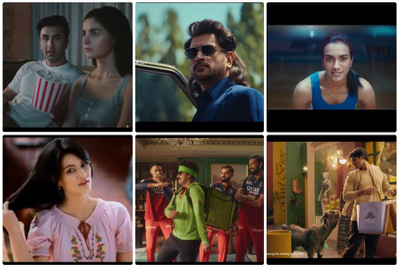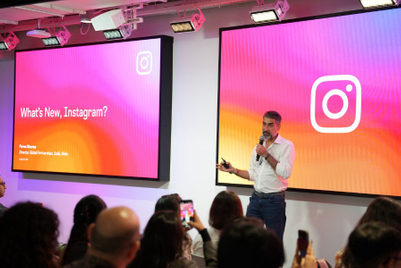.jpg&h=570&w=855&q=100&v=20250320&c=1)
Kolkata-based Aditi Adhikary loves dressing up and treats her 154K Instagram followers with a dekko of the latest in fashion and jewellery. Her recent Instagram posts posing in a salwar kameez she had ordered from Myntra garnered over 1700 likes and 450 comments.
Similarly, Surat’s Parul and Yogesh have amassed a 510K fan following on Instagram, who check out the couple’s funny posts in Gujarati. One of their recent collaboration posts for Lord Petrick Coffee and Burger got over 28K likes, with 158 people commenting on it.
These are just some examples of the burgeoning influencers emerging from tier 2 and 3 cities, and who are catching the attention of brands eager to entrench their presence in these regions. A case in point is Flipkart. While prepping its marketing campaign ahead of its Big Billion Days sale in 2022, the ecommerce company roped in over 45 regional YouTube content creators to expand its reach in tier 2 and 3 cities.
|
‘Vada Pav Girl’ and ‘Dolly Chai Wala’: Signalling the surge of regional social media stars |
There has been an aggressive rise in influencer marketing in the past few years, so much so that several brands even set aside a dedicated budget for it. A recent FICCI-EY report stated that India's influencer marketing industry is expected to touch Rs 34 billion by 2026, up from Rs 19 billion in 2023.
As businesses increasingly turn to this cohort to drive sales and deepen brand connect, what is significant is their growing inclination to partner with content creators from smaller cities. India, after all, lives in its villages. And what better way for companies to showcase and promote their wares than to work with these influencers by creating hyper-local content.

Quest for freshness
The shift towards regional influencers is largely driven by the audience's hunger for fresh perspectives, as they move away from overly saturated content seen on mainstream media. Consumers are increasingly weary of repetitive content and crave originality, which influencers from tier 2 and 3 cities deliver in abundance.
Explaining this change, Saksham Jadon, founder of Youngun, said, “One primary reason is the growing appetite of the audience for authentic content. In the past, the digital space was dominated by influencers from tier 1 cities, whose content often felt repetitive and staged. As a result, audiences began seeking out diverse perspectives, leading to the rise of influencers from smaller cities who offer more relatable and genuine content."
Influencers from smaller cities often bring unique cultural nuances and everyday experiences to the table, making their content resonate with their audiences on a deeper level. Brands now recognise the value of hyper-local content that can bridge the gap between urban and rural customer base, especially when it is in the local lingo.
Letting the money do the talking
From a content perspective, the shift towards tier 2 and 3 content creators is predisposed by several factors, with cost a key one. Collaborating with content creators from smaller cities can be more cost-effective for brands than engaging with high-profile influencers from tier 1 cities who charge relatively more. This allows brands to maximise their marketing budgets while reaching and engaging with a wider range of audiences.
Jadon explained that from a brand's perspective, working with these influencers makes more sense ROI-wise. They often deliver higher engagement at a lower cost, making the investment more efficient.

Additionally, there is the concept of attention trading—brands are gravitating towards trending influencers and creators because their topicality is significantly higher as compared to established influencers. Advances in technology and social media have made it easier for these influencers to amplify their stories across platforms, further driving this shift.
Chirag Jain, cofounder of SocialTAG, said, “Content from smaller cities also feels more genuine and less commercial, which resonates well with audiences. There is a growing pool of talented creators in these cities who are gaining popularity."
The local touch
Content from influencers from metros might not connect effectively with audiences in rural towns. Regional influencers can bring the local flavours and aspirations to the fore better, which fits in perfectly with brand that want to run regionalised campaigns.
Delivering unique perspectives in content, especially with local insights, allows brands to create more inclusive and divergent campaigns. This approach can help them tap into newer markets and demographics, enhancing their reach and relevance and also build a deeper connection with a broader audience base.
More brands are increasingly seeking moments in pop culture to strengthen their presence. Collaborating with these influencers provides an excellent opportunity to create such moments.
For example, the ‘Level sabke niklenge’ trend, which originated from a local audio clip, gained massive popularity, and was adopted by football clubs, IPL teams, and even non-resident Indians. By embracing the distinct voices of these influencers, marketers can craft narratives that stand out and make a lasting impact in moment marketing.
Long-lasting or ephemeral?
While the shift towards content creators from smaller cities is working out well for both the marketers and the audiences, not every tier 2 or 3 influencer is a perfect brand fit. Brand alignment is still crucial to maintain their image in front of society.
Moreover, Hitarth Dadia, partner and CEO of NoFiltr Group, explained that building genuine relationships can take a lot of effort for influencers in far-flung regions. However, with the right approach, it is possible.
It all boils down to regular communication, understanding their audience, and valuing their unique perspective. "We should remember that influencer marketing is a two-way street. By fostering trust and transparency, brands can build long-lasting partnerships with these rising stars, no matter their zip code," he added.
To remain relevant, influencers will need to create content that connects with their target audiences. There is always the concern that current novelty around their persona could wear off, or their content will reach a saturation point. Continuous evolution is the key for thriving in the cluttered digital space, and also keep those brand associations coming in.


 RELATED READ:
RELATED READ:.jpg&h=334&w=500&q=100&v=20250320&c=1)
.jpg&h=334&w=500&q=100&v=20250320&c=1)
.jpg&h=334&w=500&q=100&v=20250320&c=1)
.jpg&h=334&w=500&q=100&v=20250320&c=1)
.jpg&h=334&w=500&q=100&v=20250320&c=1)
.jpg&h=334&w=500&q=100&v=20250320&c=1)
.jpg&h=334&w=500&q=100&v=20250320&c=1)
.jpg&h=334&w=500&q=100&v=20250320&c=1)

.jpg&h=334&w=500&q=100&v=20250320&c=1)





%2c+marking+a+strategic+shift+as+the+agency+sharpens+its+focus+on+digital-led+brand+building+and+integrat.jpg&h=268&w=401&q=100&v=20250320&c=1)
.jpg&h=268&w=401&q=100&v=20250320&c=1)
.jpg&h=268&w=401&q=100&v=20250320&c=1)
